Overview
The most damaging pests of wine grapes are grapevine mealy bugs, snout beetles and ants. These pests also have a close relationship with each other because the chemical control of one can kill the natural enemies of the other.

These pests must therefore be controlled together. Several pests occur in a vineyard and the following insects can sometimes be a problem: Phylloxera, ematodes, margarodes or ground pearls, grapevine mealy bugs, ants, snout beetles, bud mites, erinose mites, snails and long-horned grasshoppers.
Phylloxera
Phylloxera is a small aphid that lives in the soil and feeds on the roots of the vines. It is especially active during September to May. Under certain conditions, it can also feed on leaves and is recognizable as a gall on the underside of the leaf.
Digging up and researching the roots of weak vines can reveal the yellow insects on the damaged parts of the roots. Phylloxera occurs more frequently in heavy soils and ungrafted vines is more susceptible for this pest. Ungrafted vines are vines that grow with their own roots. The most common method of control is to use tolerant rootstocks such as Ramsey.
Nematode

Nematodes are microscopically small and damage the root systems of the vines. Some nematodes live inside the root and can cause root knot, while others only live in the ground and attack the roots externally. Chemical control of nematodes should only be considered after analysis of the soil and roots and should be applied as recommended.
As with phylloxera, nematode-tolerant rootstocks can also be used. Certain cover crops such as African marigolds and oilseed radish (Raphanus sativus subsp. Oleiferus) have a suppressive effect on nematode numbers. Nematode insecticides are generally very toxic. It should be handled and administered with care and always under supervision.
By Vinpro